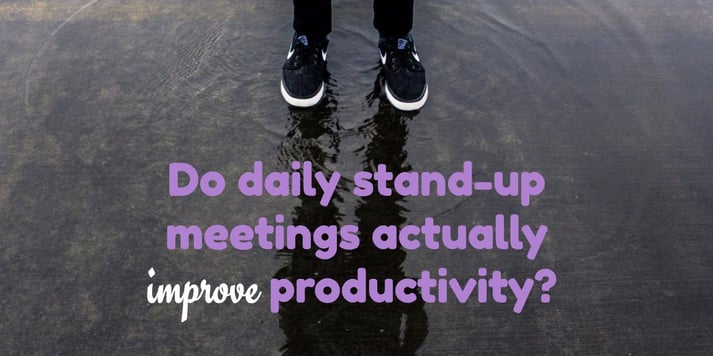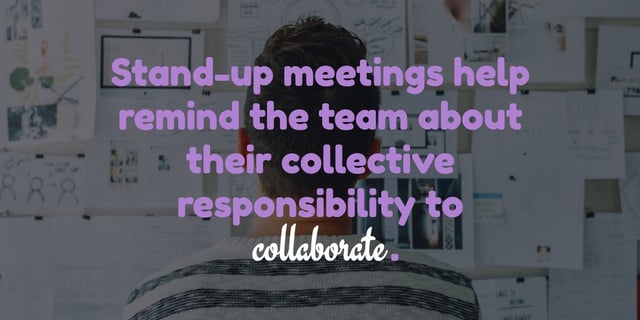
Stand-up meetings didn’t get their start in Silicon Valley where many business and productivity trends originate. Rather Lieutenant General William G. Pagonis brought this practice to the business world after a 29-year Army career, including service as the Logistical Chief of the First Gulf War. As it turns out, the same stand-up meeting technique Pagonis used with officers in the Gulf War became effective with the supply-chain employees at Sears, where Pagonis worked as VP of Supply Chain Logistics after retiring from the Army. Today, businesses large and small utilize stand-up meetings for quick check-ins and updates.
You may know them as daily check-ins, scrum meetings, or standups—whatever you call them, there are certain pros and cons that can make these meetings effective for the engineering industry.
As the name suggests, a stand-up meeting means just that: a meeting where you stand up (rather than sit). Pagonis says he used this method because, “When you sit down, a meeting goes for over an hour or an hour and a half, and you lose everybody. When people are standing, they talk faster or they say I don't have anything to add.”
While the idea of stand-up meetings has evolved over the last couple decades (some don’t even stand or meet in the same room), the idea behind it persists: efficiency.
Whether you sit, stand, or report in from email or an online messenger, your focus should be on determining what’s completed, what’s going to be accomplished today (or near future), and what obstacles are keeping someone from completing those tasks and projects.
If so many companies are doing it, they must be pretty effective and improve productivity, right?
Not always. It took Rajeev Kumar Gupta of Siemens one scrum meeting to identify seven major problems holding back a team from a productive stand-up meeting. In his article, he discusses some major mistakes teams can make that keep them from getting the most, or anything out of a daily stand-up.
A few major takeaways we can remember from Gupta’s experience include some basic things that stand-up meetings are not:
- Planning meetings
- Micromanaging opportunities
- Meetings for the leader only
How to make daily stand-up meetings more productive for engineers
If you want stand-up meetings to be productive for engineers, consider the following tips.

Keep it simple (and efficient).
Stand-up meetings are for project updates and obstacle identifiers and should last a set amount of time without going over (about 15 minutes should do).
Stand-up meetings help remind the team about their collective responsibility to collaborate.
This allows a team of engineers to know the status on each part of the project or sprint and what, if any, obstacles are impeding progress. Establish some main points to cover (i.e., the same three questions to answer each day) and stick to that. This will help you identify the problems that can be solved outside of the stand-up meetings with the right people and the right tools.
You don’t need to do any planning, analyzing, or problem-solving in these meetings. If anything comes up in the daily standup that is outside of the three main questions, put it on the sidebar to be discussed ‘offline’ with the appropriate people after the meeting.
Typical questions reviewed in a daily stand-up meeting include:
- What did you do yesterday?
- What will you do today?
- Are there any obstacles blocking your progress?
Scrum Training Series put together a great video showing a sample scrum meeting in action.
In this example, we see the scrum master pass a ball around allowing each member of the development team to answer the three stand-up questions and move cards on the taskboard to visualize the sprint backlog.
- Yesterday, I finished mapping the legacy database schema. [Moves card from ‘In Progress to Completed.’]
- Today, I’ll start on the code to read the grades from the legacy database, writing tests at the same time. I’d like to pair with Andy on this. [Moves card from ‘Not Started’ to ‘In Progress.’]
- I am uncertain whether the automated tests should go all the way to the database tables written by the legacy system, or if I should just use mock objects. [Andy says he has some ideas and offers to work with her on it. They will discuss after the meeting]
Set the standard.
Team members should take time to consider what they will share in the meeting before the meeting occurs. Too much time is wasted and other members go unheard when people wait until the meeting to think about what they will say. If your daily stand-ups turn into a mindless check-ins, your engineers will not put the effort in to make them productive meetings. Engineers are smart people who will be able to see right through something that feels more like a check box than a source of growth and productivity.
Instead, create a culture where your stand-up meetings are highly-valued parts of the process, not obligatory check-ins. That starts with the meeting leader, often called the scrum master. As with anything in a business or community, when the leader believes in something and practices what he’s asking of his followers, he gets buy-in from the group. Establish meeting expectations from the beginning (including meeting time, place, duration) and set the purpose with the group.
Be honest about obstacles.
To keep your stand-up meetings productive and not monotonous time wasters, you cannot forget the third topic covered in the questions: obstacles. Teams can report all they want about what is or isn’t being done, but productivity doesn’t happen from reporting statuses. Discussing the obstacles and risks your engineers face will facilitate communication and create a movement toward progress.
Get the right tools.
Take advantage of resources that help keep daily stand-up meetings more productive. A quick Google search reveals the vast number of bots and tools available to run your stand-up meetings with Slack alone. For example, if you work with a remote team, Howdy bot will collect information from your team and deliver a report back to the manager and team! More productivity apps for engineering stand-up meetings and progress tracking include:
Daily stand-up meetings can improve productivity if handled the right way. Follow these tips to keep your daily stand-ups efficient and productive for your team of engineers. If you’re looking for way to keep your projects productive, you need a guide to help you define your statement of work.
Developing a definitive SoW is the best way to manage your demanding project and budget. Download the Statement of Work Checklist to make your next project a successful one.



